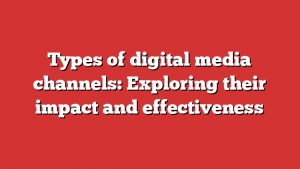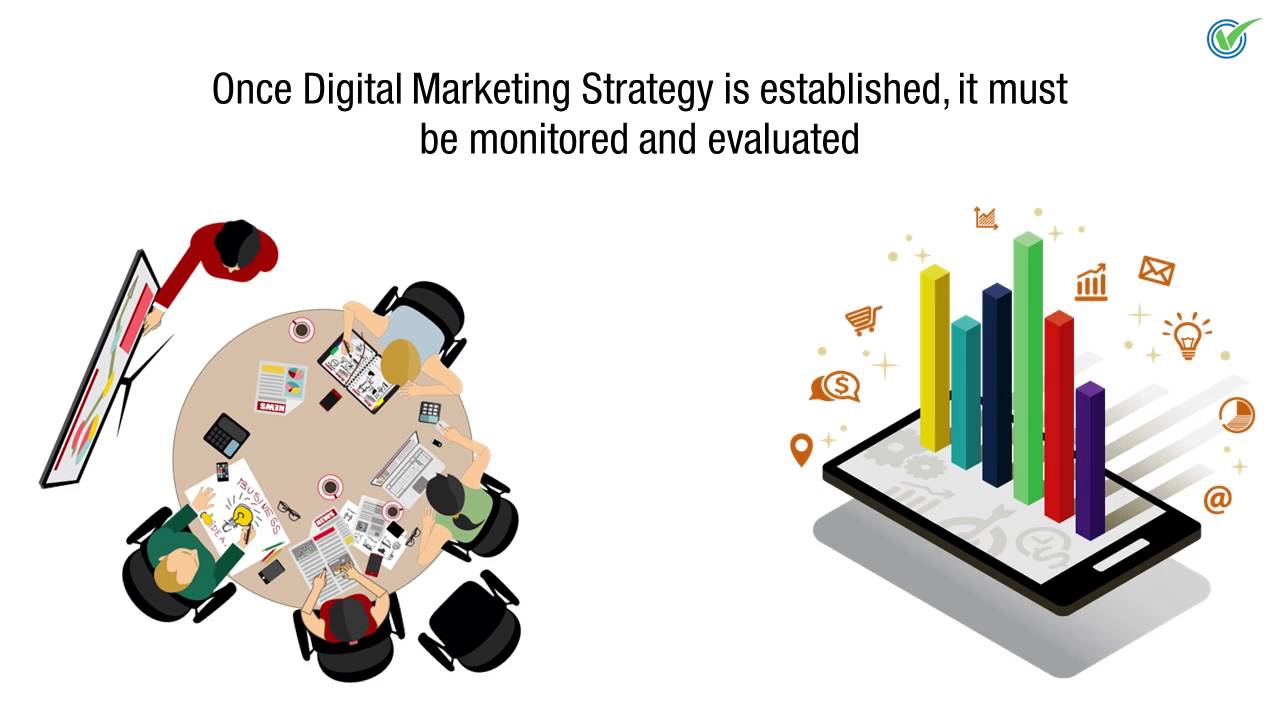In today’s fast-paced digital age, the world of advertising and marketing has undergone a tremendous transformation.
Gone are the days of relying solely on traditional methods to reach consumers.
Instead, businesses are now harnessing the power of various digital media channels to make their mark in the virtual realm.
From search engine marketing to social mediamarketing, this updated list of types of digital media channels is sure to ignite your curiosity and open your eyes to the exciting possibilities of modern marketing strategies.
Buckle up, because we’re about to embark on a journey through a digital landscape like no other.
| Item | Details |
|---|---|
| Topic | Types of digital media channels: Exploring their impact and effectiveness |
| Category | Marketing |
| Key takeaway | In today's fast-paced digital age, the world of advertising and marketing has undergone a tremendous transformation. |
| Last updated | December 30, 2025 |
types of digital media channels
The types of digital media channels include search engine marketing, social media marketing, email marketing, display advertising, public relations, and partner marketing.
These channels are all effective ways for businesses to reach and engage with their target audience through the use of digital platforms.
Key Points:
- Search engine marketing, social media marketing, email marketing, display advertising, public relations, and partner marketing are types of digital media channels.
- These channels allow businesses to reach and engage with their target audience through digital platforms.
- Search engine marketing involves promoting businesses through search engines.
- Social media marketing involves promoting businesses through social media platforms.
- Email marketing involves promoting businesses through email campaigns.
- Display advertising involves promoting businesses through visual ads on websites and apps.
Check this out:
? Did You Know?
1. The term “podcast” was coined in 2004 by combining the words “iPod” (referring to Apple’s popular portable media player) and “broadcast.” Initially, it was solely associated with audio content, but it has now expanded to encompass various forms of digital media.
2. Did you know that the first YouTube video, titled “Me at the zoo,” was uploaded on April 23, 2005? It features Jawed Karim, one of the platform’s co-founders, simply standing in front of some elephants at the San Diego Zoo for 18 seconds.
3. Snapchat, the popular multimedia messaging app, was initially developed as a class project by three students at Stanford University. Originally called “Picaboo,” it allowed users to send photos that disappeared after a few seconds. Eventually, it evolved into the Snapchat we know today.
4. GIF, which stands for Graphics Interchange Format, was invented in 1987 by Steve Wilhite. Surprisingly, despite the common pronunciation with a hard “G” (like in “graphics”), Wilhite himself stated that it should be pronounced with a soft “G” (like “jif”).
5. The term “viral video” gained popularity around the mid-2000s, but it was coined even earlier. In 1996, a video titled “Dancing Baby,” featuring a 3D animated baby dancing to music, started circulating via email and amassed widespread attention. This video can be considered one of the earliest examples of a viral video.
1. Search Engine Marketing
Search Engine Marketing (SEM) is a digital media channel that focuses on promoting websites and increasing their visibility on search engine result pages (SERPs). It combines organic search engine optimization (SEO) techniques with paid advertising through platforms like Google Ads. SEM is an effective way to drive targeted traffic to a website and appear at the top of search results for relevant keywords.
One of the key advantages of SEM is its ability to target users who are actively searching for specific information or products. By optimizing website content and using paid search ads, businesses can ensure that their offerings are visible to potential customers at the right time. SEM also provides valuable data and insights through analytics tools, enabling businesses to refine their marketing strategies and improve conversion rates.
However, it is important to note that SEM can be highly competitive and expensive, especially for popular keywords. Proper keyword research, ad targeting, and bid management strategies are crucial to ensure a cost-effective and successful search engine marketing campaign.
2. Social Media Marketing
Social Media Marketing (SMM) refers to the use of social media platforms like Facebook, Instagram, Twitter, and LinkedIn to promote products, services, or brand messages. It involves creating and sharing engaging content, interacting with followers, and running targeted ad campaigns to reach a wide audience.
One of the major advantages of social media marketing is its ability to create brand awareness and build customer relationships. By establishing a strong social media presence, businesses can interact with their target audience on a personal level, respond to inquiries, and gain valuable feedback. SMM also provides the opportunity for user-generated content and word-of-mouth marketing, as satisfied customers share their positive experiences with their social networks.
However, it is important for businesses to choose the right social media platforms that align with their target audience and marketing objectives. Each platform has its own unique features and user demographics, and a tailored approach is necessary to effectively engage with the desired audience. Furthermore, measuring the ROI of social media campaigns can be challenging, as it often relies on metrics like engagement, reach, and brand sentiment rather than direct sales.
3. Email Marketing
Email Marketing is a direct and targeted digital media channel that involves sending commercial messages to a group of email subscribers. It is a cost-effective and efficient way to engage with customers, promote products or services, and build brand loyalty. With the advent of advanced marketing automation tools, businesses can segment their email lists and deliver personalized content to specific customer segments.
One of the primary advantages of email marketing is its high ROI potential. According to research, email marketing generates an average ROI of $42 for every $1 spent. The ability to personalize and automate email campaigns allows businesses to deliver relevant messages to the right audience at the right time, increasing the likelihood of conversion.
However, email marketing success relies heavily on the quality of the email list and the effectiveness of the email content. Businesses must ensure that they obtain permission from subscribers and abide by anti-spam regulations. Moreover, it is important to continually test and optimize email campaigns to improve open rates, click-through rates, and conversions.
Stay tuned for Part 2 of this article, where we will explore more types of digital media channels, including:
- Display Advertising
- Public Relations
- Partner Marketing
- Content Marketing
- Influencer Marketing
- Affiliate Marketing
- Mobile Marketing
FAQ
What are the different types of digital media?
Digital media encompasses a wide range of formats that revolutionize our interaction with technology. Some common types of digital media include software, enabling us to perform tasks on our devices, and digital images, which can be easily shared and manipulated. Additionally, digital video and video games offer immersive experiences for entertainment and storytelling. Web pages, websites, and social media platforms have transformed how we connect and communicate in the digital age. Furthermore, digital data and databases facilitate efficient storage and retrieval of information, while MP3s and other digital audio formats revolutionize how we consume and enjoy music. Finally, electronic documents and electronic books provide convenient alternatives to their physical counterparts, enhancing accessibility and portability.
What is a channel in digital media?
A channel in digital media refers to a platform or avenue utilized by brands to disseminate and promote their products or services in the digital sphere. These channels encompass various platforms such as search engines, social media networks, email platforms, and websites. They play a crucial role in enhancing brand visibility, establishing trust and credibility, and driving sales. By utilizing these channels effectively, brands can effectively reach their target audience and convey their marketing message in a captivating manner, thereby amplifying their online presence and success.
What are the five digital channels?
In the digital landscape, there are five prominent channels for businesses to leverage their marketing efforts. Search Engine Marketing (SEM) or Pay-Per-Click (PPC) campaigns prove highly influential in optimizing conversions and driving traffic to websites. Another crucial channel is Search Engine Optimization (SEO), which focuses on improving organic rankings and visibility in search engine results. Additionally, Email marketing presents a direct and personalized approach to engage with potential customers. Social media marketing offers an avenue to interact, build brand awareness, and reach a wider audience. Lastly, Video marketing has gained prominence as an engaging tool to showcase products, services, and brand stories, capturing the attention of users across various platforms.
What types of digital marketing channels you can use?
In addition to websites and email, there are several other types of digital marketing channels that businesses can utilize. Social media platforms provide an excellent way to engage with audiences and promote brand awareness. Organic search, also known as search engine optimization (SEO), is crucial for appearing in search engine results and driving organic traffic to your website. Paid search, or search engine marketing (SEM), allows businesses to display ads in search engine results pages and drive targeted traffic through paid advertising. Mobile marketing is another important channel, as it allows businesses to reach consumers on their mobile devices through apps, mobile websites, and SMS marketing. Display ads, whether through banner ads or video ads, can also be effective in reaching target audiences. Finally, affiliate marketing, where businesses partner with other individuals or businesses to promote their products and earn a commission, can be a profitable channel for driving sales and generating leads.
New optimization ideas included — stay ahead.
Performance Marketing Tips • Self-Serve DSP Platform • Programmatic Advertising • Buy Traffic • Advertising Platform for Marketers











